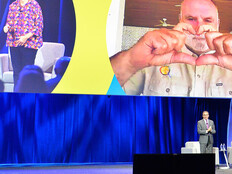Telecardiology Plays Central Role in Cancer Care
At Spectrum Health, a not-for-profit system that includes 14 hospitals and 155 ambulatory sites, general cardiologists can give full exams via telemedicine.
Patients simply go into regional hospitals or clinics for their appointments, where telemedicine units are used to monitor a variety of screening and diagnostic tasks conducted by nurses and medical assistants — with those parties and a remote doctor communicating via cameras and high-definition screens.
“It’s really an extension of us,” says Dr. Wissam Abdallah, a cardio-oncologist at Spectrum Health. “Aside from physically touching patients, we can pretty much do everything we would need to do to evaluate these patients.”
What is your health system's primary use of #telecardiology? #HeartMonth #HealthTech
— HealthTech Magazine (@HealthTechMag) February 17, 2020
Spectrum Health’s regional hospitals are located as far as one and a half hours away from its flagship location. “If something can be taken care of locally, there’s really no need to drag the patient down for a clinical appointment,” Abdallah says.
This can especially helpful for patients who have developed cardiac complications as a side effect of cancer treatment.
“They’re already wiped out; they already have a lot on their plate,” Abdallah says. “If they can just go to their local clinic, that saves them a lot of time and effort.”
READ MORE: Learn how wearables are helping fight heart disease.
Telemedicine for Pediatric Cardiology Makes Life Easier
Children’s National Hospital started using telemedicine in 2014, but the Washington, D.C.-based healthcare system didn’t ramp up its use in cardiology until 2018, says Dr. Ashraf Harahsheh, a cardiologist at the hospital and an associate professor at the George Washington University School of Medicine.
The organization launched the effort with a pilot study using 18 families of children who were already existing patients with hyperlipidemia, hypercholesterolemia or syncope, or who needed to discuss cardiac testing results.
Six months after their virtual visit, none of the participants had urgent cardiology issues, researchers found. Although 39 percent had additional in-person visits, none were a result of problems with the virtual visit.
Harahsheh conducts these virtual appointments via Zoom videoconferencing, which helps busy families adhere to their typical schedules without missing much work or school. One young patient recently conferenced in with Harahsheh while sitting in her principal’s office; her mom joined in from her office during a lunch break.
In another case, parents who lived more than 90 miles away from Washington were able to have an uninterrupted video call about a potential surgery while their child was at daycare. The method allowed Harahsheh to pick up on expressions of confusion that wouldn’t have been obvious over a phone call; their reactions helped guide the discussion.
Harahsheh now dedicates two days a month solely to telemedicine appointments. The convenience also benefits families in need because he can take on more new patients due to the time savings.











